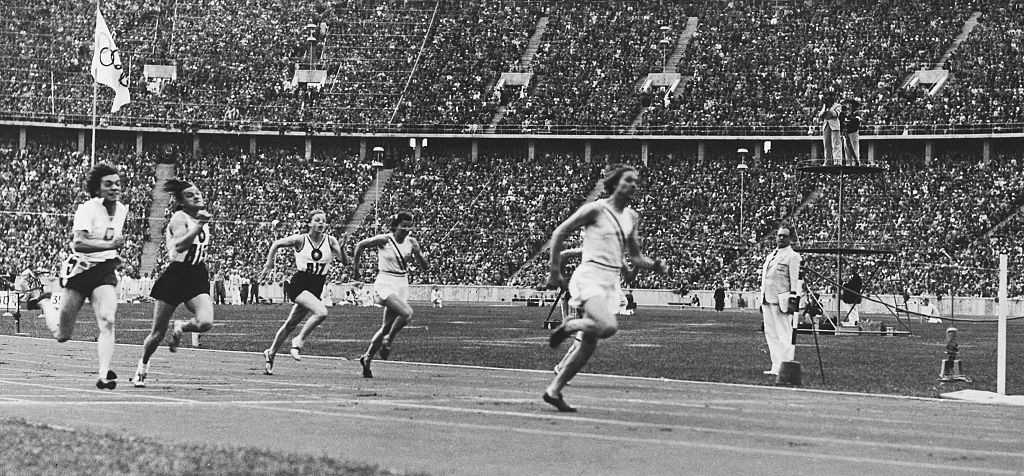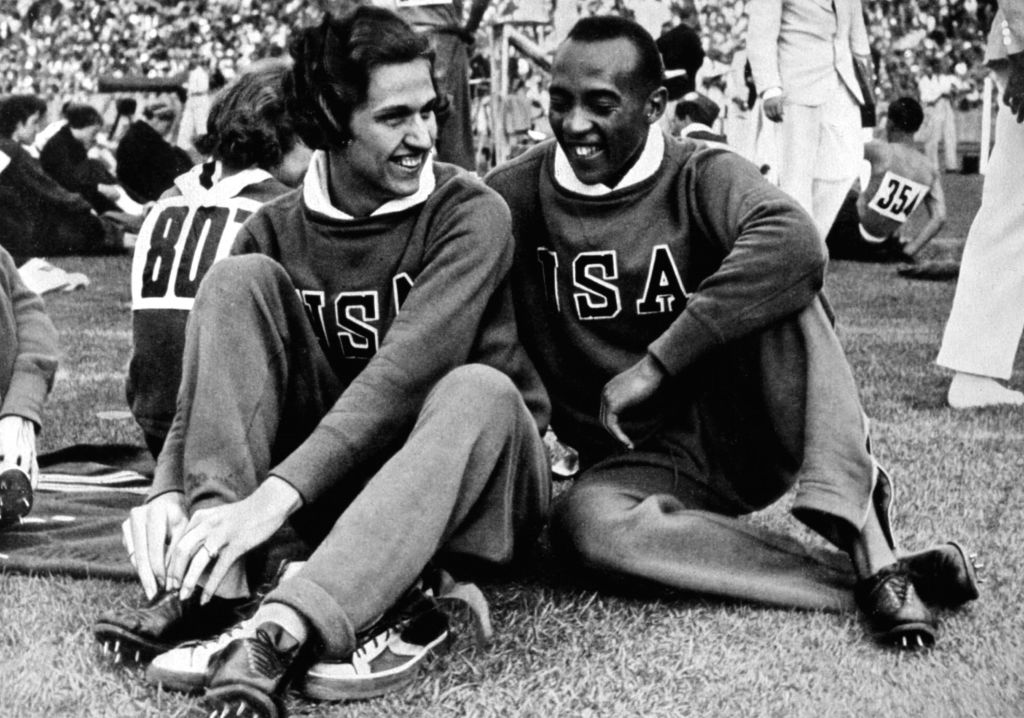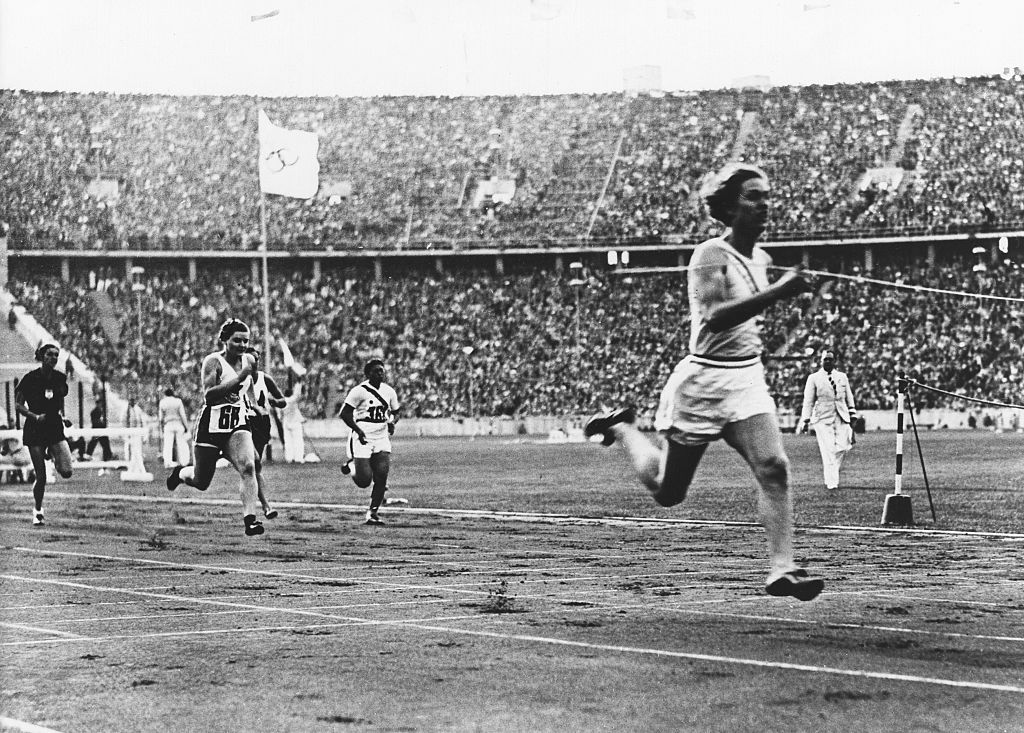This article is based on research from The Other Olympians: Fascism, Queerness, and the Making of Modern Sports, available for purchase now.
On the morning of Aug. 5, 1936, Helen Stephens was supposed to be on top of the world. The day before, she had won the Olympic gold medal in the 100-meter dash. She'd defeated her longtime rival, a Polish sprinter named Stella Walsh. Then, it all fell apart. That morning, a Polish newspaper, the Warsaw-based Kurier Poranny, published a curious accusation: Stephens, the paper alleged, was not really a woman at all. "It is scandalous that the Americans entered a man in the women's competition," the paper plainly stated.
The accusation should have been dismissed outright, the ravings of a paranoid sportswriter frustrated by the defeat of one of his country's top stars. But at the Nazi-run Berlin Olympics, where street sweepers and bus drivers were dressed in brownshirt uniforms, the story had juice. At a press conference, a European journalist translated the article aloud for Stephens. Instead of expressing sympathy, the reporter dug in. "Are you really a woman? Are you disguised, a man running in women's races?" the reporter asked her, as Stephens recounted to her biographer decades later. Stephens recalled snapping back that the rumors were just "sour grapes."
In the history of the Olympics, the firestorm is perhaps the first high-profile example of sports leaders questioning the sex of an athlete. While male officials had whispered before about women athletes who didn't conform to their notions of femininity, never before had such a direct accusation been made out in the open. In fact, by speculating about Stephens's sex, that Polish sportswriter codified what would soon become a familiar narrative at the Olympics—that women who didn't fit specific gender norms were inherently suspicious. You can draw a direct line between the accusations about Stephens in 1936 and the policies that largely bar women like Maximila Amali and Caster Semenya, and trans and intersex women in particular, from sports today.
"Helen Stephens is one of the first accusations that really reverberates around the world," Lindsay Parks Pieper, a professor of sports management at the University of Lynchburg and the author of the book Sex Testing: Gender Policing in Women's Sports, told me. The controversy around her seemed to spin forward the first sex-testing policies at the Olympics, passed just days later. "This was the ammo that sports organizers were looking for to launch testing," Pieper said.
Today, with many sports federations having instituted policies that all but ban many trans and intersex women from sports, I think Stephens's story is worth returning to. By understanding what happened to Stephens, we can trace back the moment when sports officials first decided that women who didn't meet their definition of femininity weren't just a nuisance—but rather should be policed out of sports altogether. Sex testing wasn't some inevitable policy. It was a choice that officials made based on rumor and fear-mongering, and we are still living out the consequences of that choice nearly nine decades later.
Yet Stephens deserves a spot in the halls of sports memory on her own merits, too: In 1936, she was not just the fastest woman in the world. She was also a high-profile lesbian athlete.
Stephens was always sure of who she was. Growing up on a farm in Fulton, Missouri, she rebuffed her mother's requests that she learn to play the piano, opting instead to help her father herd cattle. Every morning, she jogged the mile from her house to her middle school. Her cousin, who occasionally tagged along, traveled on horseback just to keep up with her. One day, as a child, she tripped and fell in her front yard. A wooden arrowhead she was wearing around her neck pierced her larynx, leaving her with a raspy voice that would eventually be compared to a man's.
In high school, the track coach at Fulton High School persuaded her to try out for the team. He decided to start her out doing the 50-yard dash. When Stephens ran, the track coach looked at his watch, then at her, "puzzled-like," Stephens explained in the sole book about her life, The Life of Helen Stephens: The Fulton Flash. He told her he didn't quite get her time and asked her to run it again. When he clocked her the next time, it was nearly the same result—an astonishing 5.8 seconds.
Neither Stephens nor her high school had much money to spend on her budding athletic career, but they made it work. In the spring of 1935, a year before she would become world-famous, her coach drove her to a national track competition in his beat-up Ford. The school gathered up just enough money to book a hotel room. In a surprise win that put her on the national radar, Stephens beat out Stella Walsh, then considered to be the fastest woman in the world. Walsh refused to accept the loss. She accused Stephens of starting before the gun went off; that "greenie from the sticks," Walsh said, would not have beaten her otherwise. But the two seemed set for a rematch at the next year's Olympics.
Getting to the Olympics wasn't the only thing on Stephens's mind in 1935. At the same time as she was racking up medals, she was falling in love. She had been dating girls since high school, and she continued to exchange flirtatious letters with multiple correspondents. It was a complicated time to be a queer woman in sports, of course, and going public wasn't really an option. In the 1930s, "there's this sort of creeping lesbian suspicion and more and more use of terms like 'mannish,'" Susan Cahn, a professor at the University at Buffalo and a longtime researcher of queer women athletes, told me. Other women, like Babe Didrikson, who had quietly slept with women, were broadcasting their heterosexuality. Didrikson, for instance, reversed her previous criticisms of marriage, and trumpeted her desire to marry a man.
Stephens made no such overtures to heterosexuality. The following spring, on the steamship from New York to Germany, she sent letters to a girlfriend back home. "I never had the impression that she felt conflicted about her sexuality at any point in her life," Heather Richmond, a senior archivist at the State Historical Society of Missouri who manages Stephens's archives, told me.
Those around Stephens sensed she was different, even if they couldn't quite put a finger on why. Aboard that steamship to Germany, the American diver Velma Dunn wrote to her mother that Stephens "acts very mannish and talks lower than most men." Meeting her in person, she said, was "the surprise of my life." The rumors only intensified when Stephens arrived in Berlin. The DNB, Nazi Germany's official press office, reported that "there was always a bit of a panic in the [women's dorms] when Helen Stephens's masculine voice echoed through the corridors."

Stephens's easy 100-meter victory at the Olympics on Aug. 4—in which she cruised to the finish line, well ahead of Walsh, in a record-breaking time of 11.4 seconds—only crystallized the suspicions. After watching the race, a CBS radio reporter told his American audience, "I can tell you there are a lot of fellas running for colleges in the United States today who can't run 100 meters in 11 and four-tenths seconds." Perhaps the reporter meant it as a joke—but not everyone was so light-hearted.
After the Kurier Poranny alleged that Stephens was not a woman, the story took a turn. Hours later, American newspapers published a report, attributed to unnamed "German Olympic officials," that the Germans had already medically examined Stephens ahead of the games and concluded that she did fit a conventional notion of femininity. It was an explosive story, possibly the first example of sports officials inspecting an athlete in order to determine whether she met their definitions of "woman." Most dramatically, in this case, the inspection seemed to have been done by Nazi-controlled sports officials. But Avery Brundage, who was overseeing the American team, immediately denied the claim. He told the press that the Germans "would not have anything to do with such a matter."
Exactly what happened during the Olympics is difficult to parse. While researching Stephens for my new book, The Other Olympians: Fascism, Queerness, and the Making of Modern Sports, I combed through the IOC archives, and I couldn't find anything to substantiate it. Other historians have run into the same gaps in the record. "I think it's unlikely that there was a gynecological examination of her," Joanna Harper, the author of Sporting Gender: The History, Science, and Stories of Transgender and Intersex Athletes, told me, but "it’s difficult to suggest what did or didn’t happen."
Stephens's sole recollection only complicates the picture further. Decades later, she implied to her biographer that "an Olympic committee physician" had "sex-tested all athletes prior to competition." In 1936, doctors were regularly checking American athletes to assess their health, and Stephens likely did sit through a basic physical before the Olympics, but the goal was usually to make sure the athletes were physically well, not to check their sex. Maybe, in the decades since, Stephens had misremembered. Or maybe she had really been singled out.
Sex test or not, Stephens had found herself, unwittingly, at the center of a monumental policy shift in sports. On Aug. 10, a week after her gold medal win, the International Amateur Athletic Federation, the athletic body that oversees track-and-field sports, instituted a vaguely worded policy allowing the organization to medically examine athletes whose sex was, in some way, in doubt. It was the basis for what would become a sprawling sex-testing apparatus that still bars many trans and intersex women from Olympic sports. Today, the IAAF—which has rebranded to World Athletics—all but bans trans people from competing.
"What happened in '36 certainly was a forerunner of what would happen later, in the '50s and '60s, and then all the way up to today, where it has become a question of exactly who should be eligible for women’s sports," Harper said. "A lot of what we are looking at today can be traced all the way back to the '30s and especially to the '36 Olympic Games."
The accusations about Stephens's gender, however unfounded, didn't end with the Olympics, as she surely had hoped they would. By the end of the summer, while attending William Woods University in her hometown of Fulton, she couldn't escape suspicion. When a first-year student befriended Stephens, the dean of students called the young student into her office to warn her about Stephens. "I’m sure you're aware that there are two sexes," the dean, fidgeting with her pencil, told the student, according to The Life of Helen Stephens: The Fulton Flash. "Well, you know there are some that are not truly male or female." Stephens, the dean warned, belonged to this third category, and the first-year needed to stay away: "Don’t let them touch you or get near you."

More terrible was the inaugural issue of the magazine Look— billed as a competitor to Life—which, in 1937, ran a spread of photos under the headline "When Is a Woman Actually a Woman?" The question, according to Look, was a "chief worry among athletic officials." Look added a particularly unflattering photo of Helen Stephens. "Is this a man or a woman?" the magazine asked. "Study the above picture closely and see whether you can tell if it's a man or a woman." Furious, Stephens sued the magazine. That August, she collected a $4,500 libel settlement.
Though Stephens only ever publicly identified as a woman, some questions about her self-understanding do linger. The State Historical Society of Missouri holds a series of letters written by a girlfriend of Stephens, named Kay, encouraging Stephens to consider a sex-reassignment operation. Based on the few letters that survive, Kay seemed to want their relationship to appear more normative. "Kay was clearly fantasizing that they were going to be a heterosexual couple, and it would allow them to marry and have babies," Richmond told me. The two seemed to go back and forth discussing the possibility for close to a year, though archival gaps leave unclear whether Stephens simply wanted to be in a heterosexual-passing relationship, or if she truly wanted to live as a man. Especially because her letters don't survive, "I don't know exactly what Helen's motivations were," Richmond said.
If Stephens had any hopes of returning to the Olympics, the onset of World War II dashed them. By the end of the war, Stephens's track career was over. Instead, she started playing professional basketball, and eventually created her own team, the appropriately named Helen Stephens's Olympic Co-Eds. Eventually, Stephens moved to St. Louis, where she got a job as a research librarian at the Defense Mapping Agency. There she met Mabel Robbe, a co-worker from Illinois who had previously been married to a man. Robbe and her husband divorced in 1948; two years after, Robbe and Stephens moved in together. Together, Robbe and Stephens cooked pumpkin pie and attended friends' weddings.
Few records of Stephens and Robbe survive. The archive at the State Historical Society of Missouri contains not a single photo of the two of them together. Reporters also danced around the nature of their relationship: A newspaper story in 1984—one of the only public mentions of Robbe and Stephens together—referred to Robbe only as a "friend."
But in their daily life, they weren't hiding anything. Toward the end of her life, Stephens became active in the alumni network of William Woods University, her alma mater. She often showed up to events alongside Robbe, according to Richmond. When Robbe died, in 1986, she and Stephens had lived together for over 30 years. Robbe's obituary described her as a "longtime friend of Helen Stephens." The newspaper didn't need to elaborate. Everybody who was friends with the late, great Helen Stephens already understood what it meant.





